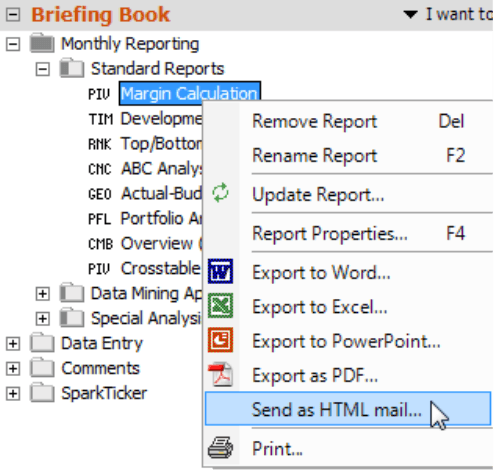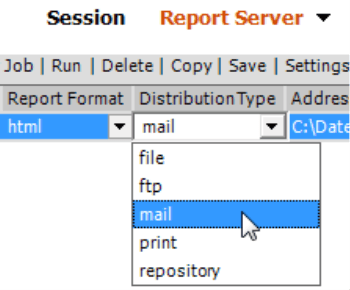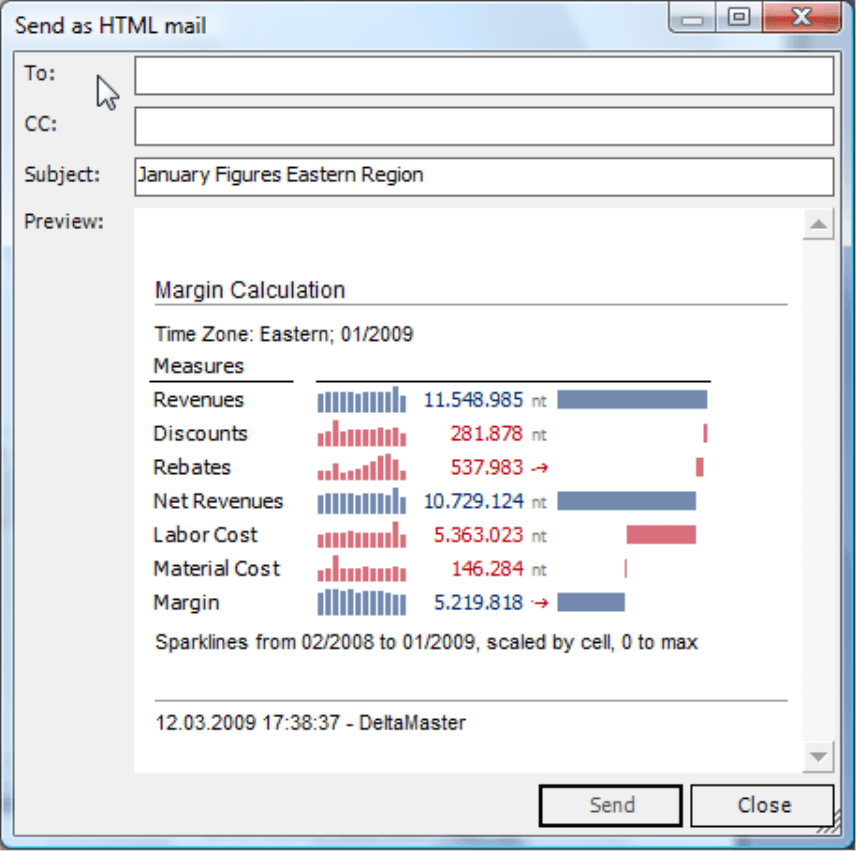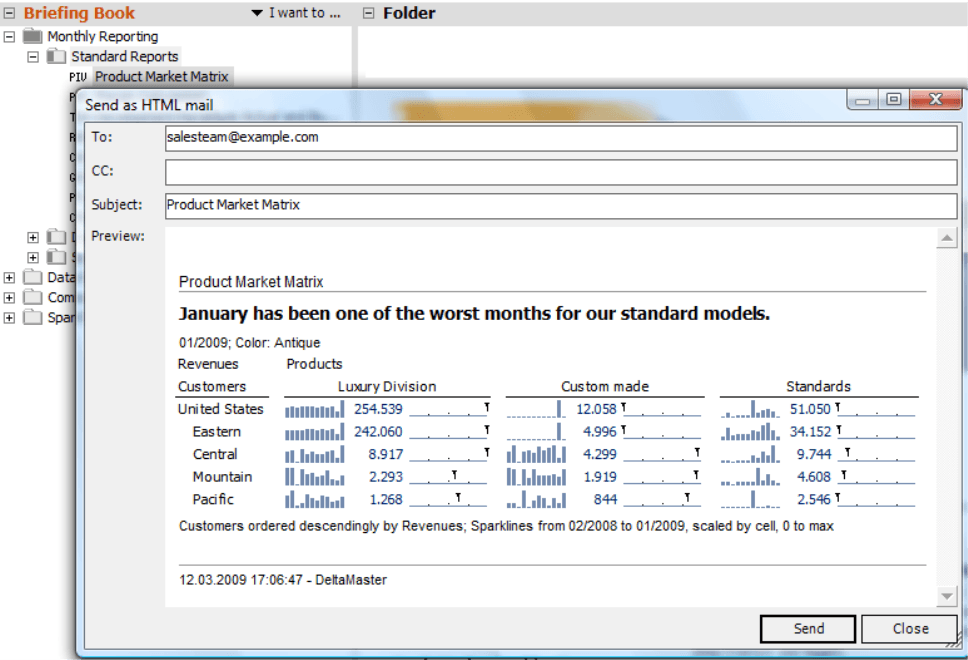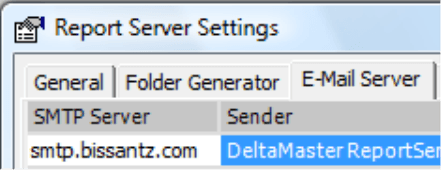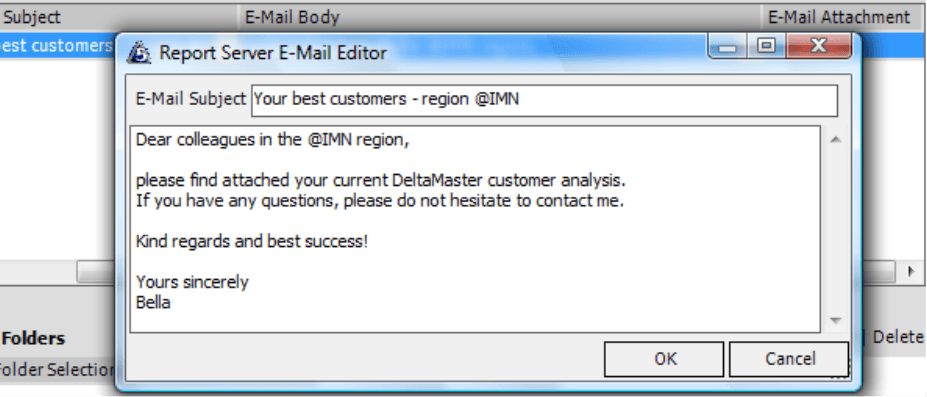Greetings, fellow data analysts!
Even though we advocate paper reports every now and then, we understand that it is almost impossible to imagine day-to-day business without e-mail anymore. For many, e-mail has become the most important medium for asynchronous communications – and mail clients have emerged as the switchboard for current events.
Electronic mail generally receives a high level of attention because it is fast, simple and direct. In addition, e-mail can easily overcome all kinds of boundaries – such as from Microsoft Outlook to Apple Mail, from Lotus Notes to an executive’s PDA, from a company network to the webmail account accessed in a hotel lobby, or from an office in Singapore to the corporate headquarters in Germany – which otherwise would be a logistical nightmare.
That’s why February’s 5.3.8 release of DeltaMaster is more communicative than ever before. With a few clicks of a mouse, you can now send informative reports in the ‘network of networks’ and ensure that everyone – who should be – is in the know. In this edition of clicks!, we will take a closer look at this new function and explain how DeltaMaster and ReportServer can help make your reports the talk of your company!
Best regards,
Your Bissantz & Company Team
![]() Even when it seems to be a bit of a detour, the Internet is often the fastest way to keep your boss, colleagues and staff informed. For partners, customers and suppliers it is definitely the case. So if you have discovered something in your data that others should know as well, you can now communicate it via e-mail in no time flat.
Even when it seems to be a bit of a detour, the Internet is often the fastest way to keep your boss, colleagues and staff informed. For partners, customers and suppliers it is definitely the case. So if you have discovered something in your data that others should know as well, you can now communicate it via e-mail in no time flat.
DeltaMaster and ReportServer support a wide range of functions to quickly dispatch your reports. The following checklist summarizes these Options:
- Do you want to send reports spontaneously or regularly?
Starting in Version 5.3.8, you can now instantly send single reports, entire briefing books, cockpits, and ad-hoc analysis results as an HTML mail from all DeltaMaster user levels. To send a mail, you can either use Microsoft Outlook or DeltaMaster’s built-in e-mail client. Outlook isn’t always at hand, but if it is, it offers the comprehensive editing and administrative functions of a full-blown mail client.
ReportServer, on the other hand, is the right tool if you want to send reports in regular intervals defined by time, events or data. In exception reporting, e-mail is the most direct and active way to inform a designated group (see page 7 for more information).
- Should reports be displayed directly in the mail or sent as an attachment?
Both DeltaMaster and ReportServer are able to generate reports as HTML e-mails. In this case, the actual report content will be displayed as a bitmap image embedded as HTML content in the e-mail. The advantage for recipients is that they don’t need any further programs to read the report. These messages can also be displayed via webmail as well as on PDAs, mobile phones or Blackberry devices.
If the recipient wants to further process the transferred information, you can send reports as attachments – ideally in DeltaMaster format (.das) or as a Word, Excel or PowerPoint file. ReportServer (Office) can automatically generate and send these formats.
- Should regular reports be connected to the database or be generated as an ‘offline’ snapshot?
Only DeltaMaster analysis sessions (.das files) remain connected to the OLAP database. Since you can open these sessions in all DeltaMaster levels including Offline reader, you can see the results even without a valid database connection. In the other levels, users can directly access the OLAP database through the session file. As a result, they can instantly access current figures and use all reporting, planning, and analysis options that their respective DeltaMaster level offers. This, however, is not possible with Office, HTML, or PDF files because they are completely disconnected from the database.
In the following section, we will focus on HTML mails, in other words, those in which the e-mail transports as well as presents the report.
HTML in the mail
In order to generate an e-mail, DeltaMaster and ReportServer both require an export template. This is a sample file saved in (X)HTML format, which describes the page structure in HTML tags. Formatting takes place using style sheets (CSS) which can describe font types, colors and spacing. Variables in the HTML framework tell DeltaMaster or ReportServer where it should enter the various components of the report that you want to export.
During the software installation DeltaMaster will save a sample template into the program directory (e.g. ‘C:Program filesDeltaMaster 5.3’). You can use this template as is or edit it as you please. For more information on editing template files, please read DeltaMaster deltas! 5.3.6, feature #12.
In ReportServer, you can use a separate export template for each job. The built-in e-mail function in DeltaMaster, however, always works with the ‘DeltaMaster.htm’ template stored in the Export template folder (defined under Extras menus, Options, Folder).
The image in HTML
The core of a report – e.g. a pivot table with sparklines, a top ten ranking, a map, a portfolio chart – will be displayed as a bitmap image which uses the same format as in Reader (e.g. ‘white style’ if activated). The names of reports and folders, notes in status lines, comments, and action titles will be exported as text. In the template file, the code for the image will look like this:
<img src=”cid:##reportimage[png]##” width=”##reportimagewidth##”
height=”##reportimageheight##” alt=”##reporttitle## – ##reportview##”>
The first expression in bold type ‘cid:’ states that the image should be transferred along with the message and that it is not stored somewhere else (e.g. on a Web server). This labeling is necessary if you want to generate e-mails within a DeltaMaster session. If you send them through ReportServer, however, you can still store the images on a Web server. When displayed, the e-mail will then load the images from the server.
The standard DeltaMaster template uses PNG (Portable Network Graphic) as the default image format. That is the job of ‘[png]’, the second bold expression in the HTML text above. If your e-mail recipients cannot see the image, try using a different format such as GIF or JPEG. Different versions of Lotus Notes and other e-mail clients have problems displaying PNG files. To change the format, simply replace ‘[png]’ with either ‘[gif]’ or ‘[jpeg]’ in the HTML text of your template.
Sending an e-mail spontaneously with DeltaMaster
You can generate an e-mail directly from an analysis session using the new Send as HTML mail option. This is located in your Briefing book under the context menu (see screenshot on page 2), in the I want to… menu, as well as in the Save menu of the Report, Cockpit, and Analysis windows. In the Briefing book, DeltaMaster will ask if you want to include only the selected report, the selected folder, or the entire briefing book into the HTML mail. In a report, cockpit or analysis, however, DeltaMaster will assume that you simply want to send that particular object.
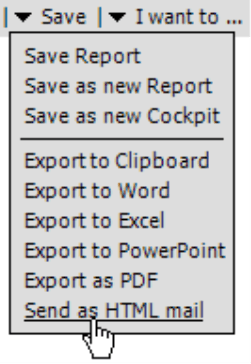
As mentioned previously, you can choose whether you want to generate the message using Microsoft Outlook or directly in DeltaMaster. This option is located in the Extras menu under Options, Export, HTML mail.
Microsoft Outlook is the default setting. If you already have this software installed on your computer, you can instantly use the mail function without any further configuration. Please, however, deactivate the ‘Edit e-mails with Microsoft Office Word’ option in Outlook.
If you want to use DeltaMaster, you will need to make a few additional specifications regarding communications with the SMTP server (i.e. the outbox server). You may already be familiar with these settings – Server, Sender, User name and Password – which are standard for every e-mail client. You can enter the server name either as an IP address or a host name. If you don’t want to use the standard port 25, you can place the desired port number after this entry, for example: ‘mail.example.com:587’. This address must be a valid e-mail address and should include an alias (‘Bella <bella@bissantz.com>’).
The DeltaMaster mail client shows a preview of the message that will be sent. Here, you can enter the e-mail addresses (separated by commas) of the people or groups who should receive the message. You can also send messages in carbon copy (‘CC:’). Although you can change the subject line, you cannot alter the content of the mail. Therefore, if you want to explain your report, you should first create comments or add an action title to your report and then save it to your briefing book prior to exporting the mail.
Sending e-mails regularly with ReportServer
You can also automate the process of sending reports in DeltaMaster. Since ReportServer takes care of all the work, you don’t even need Microsoft Outlook. You simply need to define the E-mail server in the Properties menu of ReportServer.
The four parameters – SMTP server, Sender, Account name, and Password – are identical to the properties for sending a spontaneous mail. These apply to all jobs that are run on that particular computer and have a ‘mail’ Distribution type.
You can also set additional options for each individual job. The following are relevant for sending e-mails:
- Report format: This covers all available formats except for ‘repository’. If you want to send reports that are directly displayed in the recipient’s mail client (i.e. without opening an attachment), select ‘html’ format. In this case, ReportServer will create messages that are identical to those sent spontaneously as described above. In order to run an HTML export, however, you will need a license for ReportServer Office.
- Distribution type: This is the simplest and most important property for e-mails. Here, you simply select ‘mail’.
- Address: In this field, enter the e-mail addresses that should be supplied. ReportServer can also determine the addressees dynamically using data-driven settings. For this purpose, placeholders such as ‘@IDA’ exist to reference the addresses defined in the Report recipients window, or ‘@Pxxyy’, which selects the e-mail addresses from a member property. These two options work in conjunction with the Report update and Report generator features (see also ‘E-mail subject’ further below). To test this function, simply enter your own e-mail address.
- Export template: To generate Microsoft Office files, PDFs, or HTML mails, ReportServer uses export templates which, for example, provide information on the layout of the various documents. As a result, you can create reports that apply different layouts to individual recipient groups. If you don’t select a template, ReportServer will use the standard templates that also apply in the session (e.g. ‘DeltaMaster.dot’, ‘DeltaMaster.xlt’, ‘DeltaMaster.pot’ and ‘DeltaMaster.htm’ in the folder listed in the Extras menu, under Options on the Folder tab).
- E-mail subject: In this field you can write the subject of the message that you are about to send. If you want to change the subject line, DeltaMaster will open a small editor where you can also add or delete the e-mail text. In addition, you can automatically create personalized subject lines by using the common ReportServer wildcards which will be evaluated during the job
ReportServer, for example, can replace the ‘@IMN’ variable with the name of the current generator element. Let’s assume that the Report generator in ReportServer should calculate a given analysis session (i.e. the Report source) for the North, South, East, and West sales regions and send the respective report via e-mail. If you enter ‘Sales statistics – @IMN’ for your subject line, ReportServer will enter the name of the current member in each iteration, and the subject lines will be ‘Sales statistics – North’, ‘Sales statistics – South, ‘Sales statistics – East’ and ‘Sales statistics – West’. You can assign the e-mail address of a given recipient in ReportServer if you open the Report recipient window, Create a list and enter an address for each member. In the Address field of the job definition, you refer to the ‘@IDA’ placeholder.
- E-mail text: If you want to send your reports as an attachment with DeltaMaster, Microsoft Office or PDF formats, you can enter a short introduction about the attachment, your signature or a similar text. Please note that when you chose HTML as your Export format, this entry is irrelevant because ReportServer automatically generates the message content and ignores the E-mail text field. With all other formats that you send as an attachment, however, you should never let this field go unused. After all, this message text is this first thing that the recipients see before they can open the attachment. This, therefore, provides a perfect opportunity to ‘hand over’ your message in a professional and friendly manner. You can also use ReportServer variables (e.g. ‘@IMN’) in your e-mail text.
- E-mail attachment: To give an attachment a meaningful name regardless of what the report source is called, you can create an individual file name with or without wildcards. If the attachment should be saved to a central directory (and not deleted) after sending, simply enter the respective path before the name and place an asterisk (‘*’) behind it. For HTML mails, this field is only relevant when you want to link to images saved on a Web server instead of embedding them in the mail. In this case, simply add the login information (‘ftp://user:password@server/folder’) and remove the ‘cid:’ schema label from the template.
To start the job, simply click Run in the menu bar above the job list.
Exception reporting
E-mail also plays an important role in exception reporting. In this case, the system should automatically inform a defined group that something has just happened – and what better way than in an e-mail! For more information about how you can define conditions that are regularly monitored and activate automatic alerts, please read DeltaMaster clicks! 11/2008. Here, we also address a few things to consider before you implement this type of solution.
Questions? Comments?
Just contact your Bissantz team for more information!
